

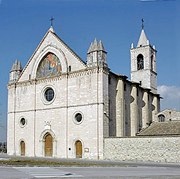
Rivotorto, which means crooked stream, is named for a steam at the foot of Monte Subasio that runs along the left side of the present church. St Francis settled in an abandoned hovel here with his first followers in ca. 1208. They probably cared for the lepers at the nearby hospice of San Lazzaro in Arce. St Francis wrote his proposed the “Form of Life” here, and travelled to Rome with his brothers in 1208 to gain approval for it from Pope Innocent III. The group returned to Rivotorto but when a local farmer stabled his donkey in their hovel, they moved to the Portiuncula.
In 1455, Fr Francesco di Ugolino Saccardi received permission from the Bishop of Assisi to build an aedicule here with an altar for the celebration of Mass. There is no indication that the friars of San Francesco took a particular interest in the site until 1586, when they proposed to build a church here. This was probably a reaction to the fact that the Observant Franciscans had begun the construction of the nearby Santa Maria degli Angeli in 1569. However, the friars found it difficult to raise the necessary finance, and construction began only in 1600: it was to be another 40 years before the church was complete.
In 1645, Fra. Michelangelo Catalano, the Guardian of San Francesco, laid the foundation stone of the adjacent convent, which he intended to house a studium. However, this foundation failed to attract many friars. This was probably because of vociferous opposition of the Observant Franciscans of Santa Maria degli Angeli.
This church was destroyed in the earthquake of 1853, and the present neo-Gothic church was built soon after.
Sacro Tugurio
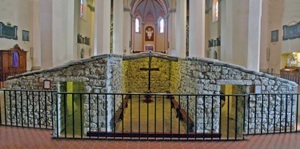
The “sacro tugurio” (sacred hovel), which is preserved at the centre of the church, is made up of three very narrow rooms: it is claimed that St Francis and his companions used the room on the right as a dormitory and that on the left as a kitchen. The structure took on its present appearance after a restoration in 1926. The central room is now furnished as a chapel.
Scenes from Life at Rivotorto (1653)
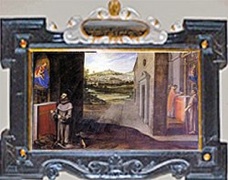
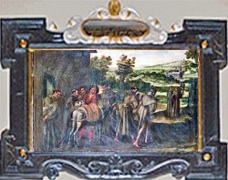
Fra. Michelangelo Catalano commissioned these twelve panels from Cesare Sermei in 1653, by which time he had become Minister General of the Conventual Franciscans. The panels depict scenes from the lives of St Francis and his companions at Rivotorto. They originally decorated the exterior walls of the “sacro tugurio”. Following a recent restoration, they are now displayed around the walls of the church.
-
✴The panel illustrated above on the left depicts St Francis praying at the Portiuncula. The church to the right is a representation of what was then the newly completed Santa Maria di Rivotorto.
-
✴The panel illustrated above on the right depicts the farmer with his donkey driving St Francis and his companions from their hovel. They are setting out for the Portiuncula, which is represented at the upper right as a small chapel, with no reference to the large basilica that had been built over it.
Mosaic (19th century)
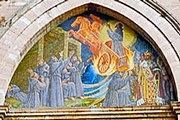
-
✴At the centre and to the left, the friars have a vision of St Francis ascending to heaven in a fiery chariot. St Francis himself was away in Assisi: his brothers “understood that the holy father, while away from them in body, was present in spirit, like a second Elijah, [and] that they might follow him as true Israelites” (Legenda Maiore).
-
✴To the right, the Emperor Otto IV travels through Assisi on his way to be crowned by Pope Innocent III and St Francis prophecies his demise.

